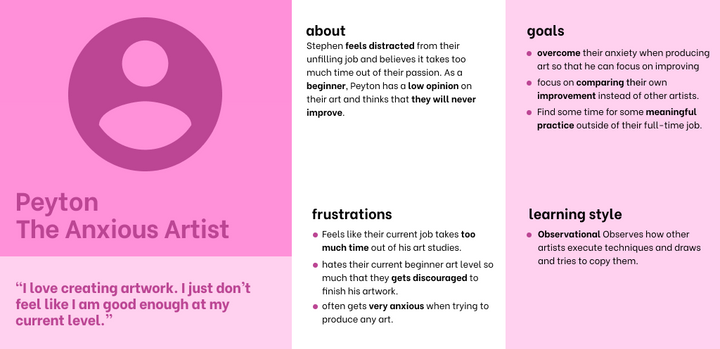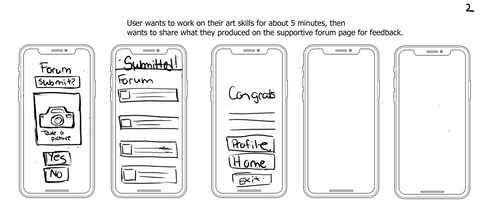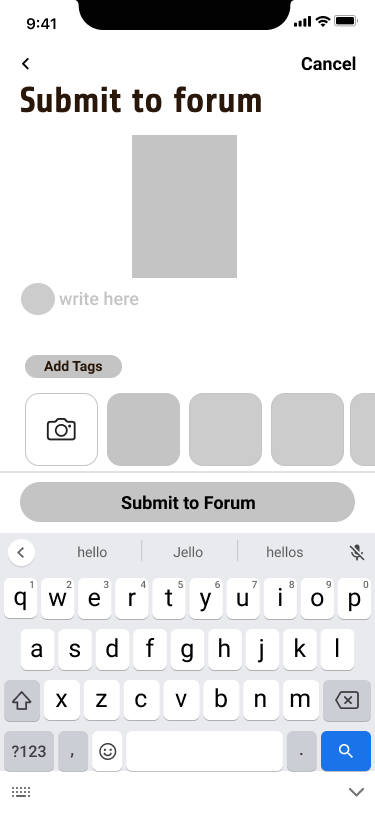Self Paced Art Training

Artistic Talent is seen as an inherited trait first, and a practiced skill second. Throughout the years there has been an influx of creative content around us. Outside of online tutorials, courses, and YouTube videos there are minimal resources for art illustrators to practice their art and improve on skills that would help them develop stronger art pieces.
I wanted to find out ways in which we could solve this problem that many artists have— Improving artistic skills through efficient techniques.
AcademArt is a self-paced art training app for new and professional artists of the like. AcademArt will be used to help improve art skills by utilizing core fundamental skills of observational practice, design elements, and consistency. Tools such as mentorship, forum support, and personal tracking will encourage artists to continue with their art progression until they have reached their desired expert level.
My Role.

I was the sole researcher, ux and ui designer for this product. I was responsible for the following,
-
Conducting extensive research and synthesis to tackle pain points that artists face.
-
Ideating designs through sketches and brainstorming.
-
Designing wireframes, and UI elements.
-
Leading User Testing to ensure validation of the designs.
-
Synthesize findings and redesign based off of user testing.
Process.
The process for the mobile app experience was as followed:
Research and
Synthesizing
Ideations
Design
Usability Testing
Synthesizing
and Redesign
Primary research, screener surveys, interviews, research synthesis, and persona development
brainstorming, HMW statements, user stories, sitemaps, user flows, sketches
Mood Board, design system, wireframing, high fidelity UI’s,
high-fidelity
prototyping, moderated user testing
Redesign based off of usability tests.
The Challenge
More often than not, artists struggle with their own art improvement. Most of their issues lie from not understanding how to practice and lack of consistency. The main challenge of fixing these problems was finding out how I can motivate artists of all skill levels to stay consistent. I also wanted to know what the easiest way for artists of different skill-levels to improve efficiently.
The Solution
I wanted artists to have a source that catered specifically to their improvement. With Academart, artists of different levels would be able to pick a vast number of options for how they would like to practice. Whether it be the casual novice who wants to pick up a new hobby, or the experienced professional improving their skills, the goal of AcademArt is to promote academic improvement while inspiring artistic creativity. Artists would have the option to learn new techniques from different mediums while having the choice of utilizing the mentorship program for guidance or participating in self practice on their own.

Research and Empathizing
Discovering the Pain Points
For my secondary research I looked up different information on how artists improve their artwork. I collected research on the following ideas:
-
why some artists improve faster than others
-
common mistakes people make when improving
-
how art can be used as a cure to an artist's anxiety.
I found my sources from articles through online research. The initial findings I had were exploring the overall techniquesof practice art. That included understanding design principles, utilizing observational drawing, and maintaining consistency. My findings showed that these were all great techniques for proper art improvement.
My research led me to an interesting conclusion. Pertaining to overall mental health, art has many health benefits. Art offers a way for one to focus their attention on something stress-free. Doodling can provide a way to ground oneself and get some peace from their own thoughts.
From there I started brainstorming ways that I could make an artist’s improvement substantial while alleviating the internal pressure most artists have about their art.
It is important to understand that an artist must not just practice for the fastest improvement but also to get the most enjoyment from the medium.
Screener Surveys
I conducted screener surveys on artists from different skill levels and backgrounds. I reached out through emails, instant messengers, and creative group chats to see which artists were interested in taking my survey.
The objective of the screener survey was to find art creatives from different walks of life and different backgrounds. Inarrowed down my research to about 5 candidates. Most of them were either art professionals or art enthusiasts. I had interviewed a recent freelancer, a 3D animator, a marine biologist that did painting as a side hustle, radiology technician that casually draws, and a graphic design creative. My candidates were diverse in different skill levels and background.


Interviews
Upon conducting interviews, I determined what mattered the most to artists of different skill-levels. Many artists seem to struggle with art anxiety. A common struggle amongst many artists is the overwhelming emotion of their work not being good enough. This could have resulted from bad criticism, lack of motivation, or comparing other artists of different skill levels. Artists of all skill levels will have this problem somewhere in their lives, and will want to aspire to improve their creative skill in some way.
some notes allocated from the interview process
Synthesizing the Research
Through Affinity Mapping , I was able to synthesize and narrow down my Interviews to some important categories that artists have faced:
-
Art mediums
-
How often they draw
-
Doing art for external purpose
-
Interest in community participation
-
Anxiety with art improvement
-
Focusing on art practice
-
Doing art for fun
-
Having jobs outside of art

It is important to note that while art mediums and having jobs outside of art is not shown on the affinity map, they are huge points that should be considered.
Personas
Affinity maps were then categorized into 3 main personas:
-
The Art Academic
-
The Casual Art Hobbyist
-
The Anxious Artist

The Art Academic
The Art Academic is an artist who is either busy pursuing or already has a profession in art. Their schedule is filled with completing art assignments or art projects for work. They try to carve time out of their day to practice fundamental skills to improve but they find it challenging. Art Academics want to find ways to squeeze in what little time they have to practice skills amid their demanding schooling and/or art profession.

The Casual Art Hobbiest
This artist normally has a full-time job outside of art and wants to do art as a casual hobby but struggles to find resources to get started. Art for them should be a stress free hobby that doesn't give them angst when working on a new project or technique. They use art to decompress and relax while actively seeking improvement. "Casual Art Hobbyists" want to have learn art as a stress-free, no pressure hobby.

The Anxious Artist
This artist normally has a full-time job outside of art and wants to do art as a casual hobby but struggles to find resources to get started. Art for them should be a stress free hobby that doesn't give them angst when working on a new project or technique. They use art to decompress and relax while actively seeking improvement. "Anxious Artists" tend to gauge their artwork on how good their skill is in comparison to other more-skilled artists.
Ideations
HMW's
The final task of my research was to create How Might We (HMW) statements to state the biggest pain points that most users wanted solved.
-
How might we make it easier for experienced artists to practice their art while having a busy schedule?
-
How might we help novice artists break into a new hobby without it being too stressful, demanding, or competitive?
-
How might we give artists a safe space to focus on their artwork instead of comparing their work to more experienced creators?
-
How might we help artists at every level improve within their work?
-
How might we help different level artists improve their technical skills?
As a User I want to
-
Know how to practice my art efficiently so that I can see some noticeable improvement
-
Have some sort of guidance by a mentor/expert to assure my art practice is correct.
-
See noticeable improvement so that I feel as if I have accomplished something
-
Overcome the anxiety I feel so that I can finish pieces with confidence.
-
Have meaningful criticism so that I know what to improve on in my artwork.
-
Practice art consistently so that I can develop good art habits.
-
Use my artwork as a de-stressor so that I can express my feelings better.
-
Log my progress so that I can track the improvement I have made.
Site Map
After narrowing down my user’s needs, I was able to create a sitemap to simplify the needs and wants users may have while utilizing my app as an art improvement resource. I did my best to organize the sitemap in a way that was understandable for the user to navigate through.

User Flows
I made some user flows to figure out the best route I would want my users to take while they navigated through my app. I created 3 hypothetical journeys for the user.

User Flow A
User wants to work on their art skills for about 5 minutes then wants to share what they produced on the supportive forum for feedback.

User Flow B
a new user wants to sign into the app
and learn how to paint.

User Flow C
A user wants to login and work on some exercises and track their growth
Sketches
Through sketching, I was able to further dissect and understand my user flows, being able to give a rough concept for how I would want my app to look and feel. Through the sketching process, I brainstormed the best way for users to navigate with ease and understanding.
Low Fidelity Wireframes
I worked in Figma to produce some low fidelity wireframes, to showcase placement of images and to further simplify the user flow process of my app. I was able to determine the spacing of certain elements within the app.

Design
Style Guide
Before moving into the high-fidelity wireframes, I crafted a style guide that would adhere to usability ease all while delivering very unique and provocative branding. I chose a simplistic, modern font and iconography to mix with the serif, academic-inspired wordmark.
High Fidelity Wireframes
With my high fidelity wireframes I was able to create a warm, yet welcoming design that balanced the idea of ease while inspiring creativity. I changed some technical navigations of the design by putting more focus on the actual tasks asked from the users in comparison to what would be shown on the navigation tab.
Usability Testing and Synthesizing
User Testing
After designing and prototyping my high-fidelity wireframes, I wanted to conduct a usability test to see if my app adhered to the tasks I asked from candidates. The usability test consisted of 5 artists from different levels, who had different creative backgrounds as well.
While conducting tests I had the prospective users complete a couple of user journeys while addressing the following objectives,
-
How user friendly and understandable the interface is.
-
If users' needs are met with the specified user routes.
-
If there should be further alternatives (if needed) for certain user flows.
-
If users feel comfortable using the exercises on the app
After objectives were specified, I documented the following tasks from the candidates,
-
Signing In and Signing Up as a user
-
Using the Practice Exercises in the app.
-
Accessing the Community forum
-
Tracking their art progress on the app.

In order to discover the importance of each issue, I made a Usability Table categorized by critical and major priorities.
Test Results
Test results were interesting, while users enjoyed the aesthetic of the application, they were having a bit of trouble performing some critical tasks of the app. Because of this issue, I did my best to start synthesizing and allocating the major pain points the users were having.
The critical issues were narrowed down to three major points.
-
Themed practice needs more categories, so that users understand where to go if they want to practice art skill pertaining to a theme.
-
Candidates wanted their specific progress on the homepage to be the first thing they see before learning about new app features.
-
Users expected the forum to have different categories for certain types of art.
Redesign
Solution for Usability Issues:
After finding out the 3 major critical pain points users had, I quickly noted some changes that could be made.
-
Design high-fidelity mockups of exercises pertaining to general categories within the "Themed Practice" tab.
-
Move the "Track Your Progress" section above the new mentor section so that users can focus on their own needs from the app first.
-
Put in different categorized tabs for users to upload their content, and different categories to prompt on the upload screen for the forum.
-
Offer users to add tags while uploading their images so that they could find specific content by category within the forum.
Final Insights,
This project really helped me gain a better understanding on how to differentiate between good UX/UI in order to make a user-friendly design. Through research and brainstorming I was able to configure the pain points of many users while designing a well thought out app that had empathized with the users wants and needs. After further redesign I appreciated the honest feedback on where my app could use work, and I felt like I delivered a more understandable version of my original mockup.

































































